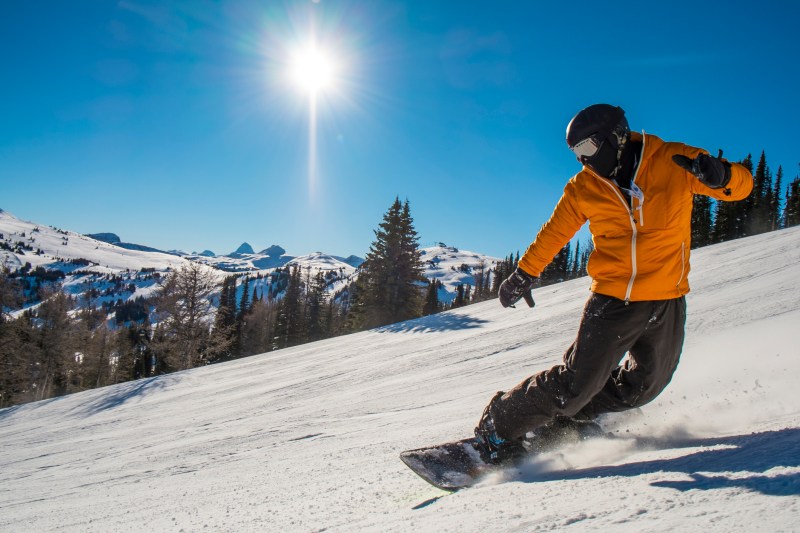
The key fundamental of snowboarding and the aim for all beginners is the hallowed ground of linked turns. Most likely, you’ll start by side slipping, with a little falling leaf to move across the hill — using your edge to zig-zag down the hill without turning. Then you’ll want to start working toward S turns, and this means transitioning from heel to toe edge or vice versa.
Every snowboarder you see has been in this position — yes, even that guy carving a snowboard and sending huge spins off jumps. Linking your turns together isn’t easy, but without it, you’ll find yourself stuck in a thigh-burning position all day. Perhaps the biggest challenge associated with linked turns is edge transition. This is the moment when you shift your weight from one edge (the uphill edge) to the other (the downhill edge) in order to initiate your snowboard turn. Doing this at the right moment, without tripping over that edge, requires practice, but we’ve got a gem that can help you out next time you’re hitting the slopes.
As Malcolm Moore explains in this video, when you’re snowboarding, you need to imagine there’s an arrow pointing out from you in the direction you’re moving (not the direction your board is pointing). The earliest point in a turn you can make any edge change is when your board matches the line of that arrow.
Understanding this advice in more detail
To understand this, it’s important to know that the angle your snowboard is pointing at and the direction that you’re traveling in — your momentum — are not necessarily the same thing. Think about when you’re side slipping. If you were to draw an arrow from the front of your snowboard, it would be pointing across the slope. Draw another for your direction of travel, and it would be pointing down the mountain, often at 90º to your snowboard arrow.
This is the same if you skid out of a turn — which most beginner snowboarders will do — rather than carving your snowboard turns. Your snowboard finishes the turn pointing across the mountain, but your momentum is still taking you downhill, meaning the snowboard’s direction is not aligned with your momentum arrow. If you’ve ever tried to change edge at this moment, you probably took an absolute whipper as your downhill edge caught and threw you off balance, downhill.
Instead, you need to control your skid and get your snowboard moving back across the slope on either your heel edge or toe edge. In other words, align your arrows. Only then should you begin to initiate your next turn. The next time you head out snowboarding, think about visualizing these two arrows. Ask yourself two questions: Where is my snowboard angle arrow pointing? Where is my direction of travel arrow pointing? When these arrows align, it’s time to turn.
As you progress your turns, you’ll find that these arrows spend more time in alignment. Your skid turns become carved, at least in part, and you spend more time with your snowboard in the fall line of the mountain. In both these positions, your arrows are aligned.
Trust me: As someone who took a fair few whippers, I learned this the hard way. Fortunately, you don’t have to.
What exactly is a ‘whipper’
A whipper in snowboarding is exactly what you might think it is — a fall or crash. Whippers can happen if you don’t take the advice here and you catch the edge of your snowboard. They can also happen if you land awkwardly or hit a hard patch of snow.
Here are some tips for avoiding whippers:
- Be aware of your surroundings and avoid riding in areas with obstacles or uneven terrain.
- Be in control of your speed and make sure you feel comfortable with the slope you’re riding on.
- Use proper technique when turning and landing (such as the above advice).
- Wear a helmet and other protective gear.
If you do fall, try to tuck and roll to minimize the impact. Whippers are a real part of snowboarding, however, with the advice given here, you may avoid them.
Editors' Recommendations
- Snowboarding tips: Set your snowboard stance for a winter of shredding
- Snowboarding tips you didn’t realize you needed: How to ride on ice
- Snowboarding for beginners: How to conquer the dreaded chairlift without falling
- New to snow sports? We have one clever trick to decide if skiing or snowboarding is right for you
- SJCAM C300 is an affordable action camera, but can it do what the Insta360 and GoPro can?





